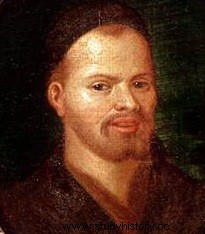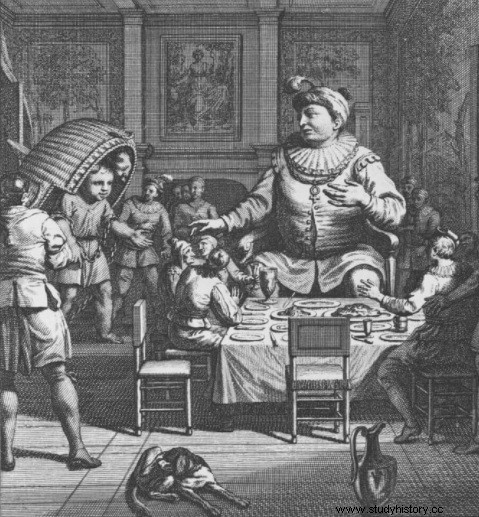 François Rabelais (circa 1483-1553) is a French writer among the first French humanists. He is notably the author of Pantagruel and Gargantua which will ensure his celebrity. His personality remains obscure and is the subject of many hypotheses. He appears sometimes drunk and pleasure-loving, sometimes erudite and passionate about letters who instructs while amusing his readers. Rabelais' work remains the symbol of linguistic exuberance, which in no way excludes scholarly erudition. The comic and the serious are inextricably intertwined in the epic and romantic adventures of the giants Pantagruel (the son) then Gargantua (the father).
François Rabelais (circa 1483-1553) is a French writer among the first French humanists. He is notably the author of Pantagruel and Gargantua which will ensure his celebrity. His personality remains obscure and is the subject of many hypotheses. He appears sometimes drunk and pleasure-loving, sometimes erudite and passionate about letters who instructs while amusing his readers. Rabelais' work remains the symbol of linguistic exuberance, which in no way excludes scholarly erudition. The comic and the serious are inextricably intertwined in the epic and romantic adventures of the giants Pantagruel (the son) then Gargantua (the father).
Biography of François Rabelais
Born in La Devinière near Chinon around 1483, François Rabelais entered the orders of the Franciscans. He studied theology, law and the Greek language and also maintained a correspondence with the humanist Guillaume Budé. At the time, the Sorbonne University, a center for theological studies, possessed significant religious authority. She condemns the study of Greek for fear of losing the monopoly of the interpretation of the Scriptures. The Franciscans confiscate the books of Rabelais.
This is why he entered the Benedictine abbey of Maillezais in 1524. However, he had difficulty complying with monastic rules. In 1528, he put on the habit of a secular priest and studied medicine in Paris and Montpellier. In 1532, he moved to Lyon and practiced medicine at the Hôtel-Dieu. It enjoys the intense intellectual activity that characterizes the city.
Pantagruel and Gargantua
 His life was then divided between Lyon, Rome and Montpellier, where he continued his studies. He had Pantagruel published under the pseudonym of Alcofribas Nasier, an anagram of his real name. The Horrible and Hopeless Deeds and Prowess of the Very Renowned Pantagruel, King of the Dipsodes, Son of the Great Giant Gargantua is a burlesque tale inspired by novels of chivalry, in which the protagonist, Pantagruel, is a giant who never stops drinking. Despite its popular success, religious authorities condemn the book. Indeed, if Rabelais denounces the hypocrisy of men, he also makes fun of the Church and the Pope.
His life was then divided between Lyon, Rome and Montpellier, where he continued his studies. He had Pantagruel published under the pseudonym of Alcofribas Nasier, an anagram of his real name. The Horrible and Hopeless Deeds and Prowess of the Very Renowned Pantagruel, King of the Dipsodes, Son of the Great Giant Gargantua is a burlesque tale inspired by novels of chivalry, in which the protagonist, Pantagruel, is a giant who never stops drinking. Despite its popular success, religious authorities condemn the book. Indeed, if Rabelais denounces the hypocrisy of men, he also makes fun of the Church and the Pope.
Despite censorship, Rabelais did it again three years later under the same pseudonym with the Inestimable Life of the Great Gargantua, Father of Pantagruel (1535), which ends with the motto:“Fay ce que vouldras” (“Do what you want”). These works represent a threat for the theologians of the Sorbonne who also condemn the Tiers livre and the Quart livre. It seems that the Fifth book is not authentic. If Rabelais escaped the stake, it was thanks to the protection of King François I and Cardinal Jean du Bellay, whose private doctor he became. It was not until 1546 that he signed the continuation of the adventures of Pantagruel with his real name.
The Work of Rabelais:teaching and entertaining
Rabelais introduced spoken language into literature. He wrote his novels in French rather than in Latin, to make his work accessible to as many people as possible. Using puns and formulas that have now become sayings ("The dress does not make the monk", "The appetite comes with eating"), he led the reader to reflect on his time.
His literary universe borrows heavily from popular oral tradition and medieval novels, while his ideas belong to the intellectual current of his time. He innovated in the religious and educational fields and advocated the reading of the Scriptures at the risk of being condemned by the Sorbonne and the clergy. He condemns purely bookish scholastic teaching and imagined an educational system based on practice and experimentation.
To go further
- The work of François Rabelais and popular culture in the Middle Ages and under the Renaissance, by Mikhail Bakhtin. Gallimard, 1982.
- The Five Books of François Rabelais. Paperback, 1994.
